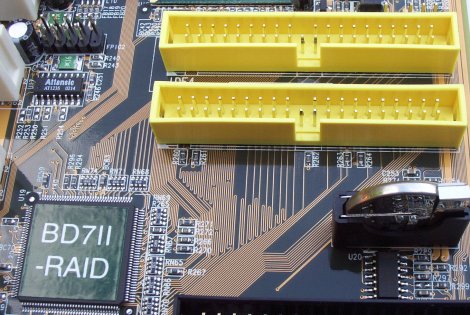Features continued
|
The revised Intel ICH4 southbridge sits to the right of the AGP bracket. The transition from i845D to i845E involved not only a change from supported FSBs (100 - 133MHz), but also the addition of an extra 6 USB2.0 ports integrated into 3 controllers on the southbridge. 2 of these ports are mounted on the backplane and a further 4 are supported via the 2 on-board headers present on the BD7II-RAID. Somewhat strangely, Intel haven't upgraded this southbridge to the newest IDE standard, ATA133. This probably shows just how useful they think it currently is. At the time of writing, only Maxtor ship drives that are compatible with this new standard.
Making an extremely common appearance nowadays is IDE RAID. The majority of RAID-bearing motherboards are divided into two camps, Promise and Highpoint respectively. I prefer the Highpoint variety for a number of reasons. The Highpoint HPT372 that graces the BD7II-RAID is fully ATA133-compatible, allows you to connect 4 IDE devices to 2 channels, offers full hot-swap capability (you can remove the drives even when the PC is operational), and offers RAID0, 1, and 0+1 support. Perfect for striping, mirroring and protecting your data. If one of your intended purposes requires fast disk subsystem speed, RAIDing drives could provide the answer. One aspect to note is the omission of ABIT's debug LCD screen found on the original BD7 and IT7. This cycled through a set number of codes as the motherboard was booting. If a problem was encountered during the process, the debug LCD would stop at a certain number that could be cross-checked against the manual for basic troubleshooting. It is useful and I can't really see why it hasn't made an appearance here. The vertically mounted CMOS battery, first shown on the MAX series of motherboards, makes its appearance once again. Considering how little 'board space we have, it certainly is a good idea.
The BD7II's backplane is pretty much standard with the exception of the RJ45 port powered by the on-board Realtek ethernet controller. Unlike the ABIT IT7, the BD7II-R retains the PS/2 ports that many users still consider essential. From a cooling point of view, the BD7II-R has 3 on-board fan headers. I personally would have liked to see another one for those who take their cooling seriously. The features on the BD7II-RAID are generally impressive. It has most of the bases covered and still manages to retain 5 PCI slots. If the IT7 didn't exist, the BD7II-RAID would have been ABIT's top-of-the-line P4 DDR motherboard.
.
|











